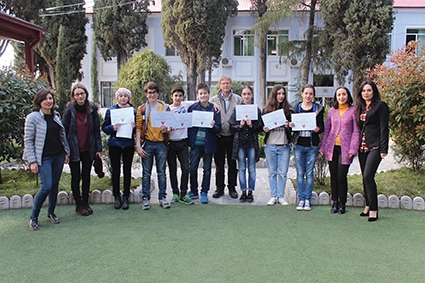Making Science Fun at Snow School
INTERVIEW
James Frankenfield, an American scientist, avalanche center founder, and now Snow School Director, came to Georgia almost three and a half years ago to spend a summer hiking. But, as it does many a foreigner, the country grabbed his heart and now he’s here to stay. GEORGIA TODAY met him to find out more.
How did you end up in Georgia?
I originally came just for the summer and even had a return ticket, but then I found a few teaching jobs that interested me and decided to stick around. While I was working with schools and various ages groups, I kept up my outdoor work in the United States. I used to do mountain guiding, and I’ve been running an avalanche center for many years.
Tell us about the Snow School Program
I knew of a program called Snow School in the United States. The program itself is very small, with its main office in Idaho supporting the program all over the country. They have different field locations and each location can have different activities and different lessons which the central program helps support with lesson plans, trainings, and equipment- snow shoes for winter walking and the like. It’s fundamentally a science program but we also hope to get students interested in the outdoors and get them active.
Why did you think the Snow School would work in Georgia?
It seemed like a good idea for this country for several reasons. One is that there’s a real need for innovation in education, and last year we organized a trip with kids that were half public and half private school. I really like that public schools could have something that is new and different and gets the children more motivated.
How does the program work in practice?
Although it’s only a short program, we hope it will help improve science education. The outdoor part of the program is one-day, but we have a science lesson in the classroom. We expect we’ll have to work with the teachers until they learn what we’re teaching. We teach some topics before and then we go and spend a day outside, and children can put their snowshoes on and travel around, dig a hole in the snow and look at the layers, or they can study how much water there is in the snow- one topic is understanding where our drinking water comes from and how to estimate how much water we’ll have for the next year. We measure how much water is there in the snow and talk about it.
Another aspect that’s very important here, and that I hope we can help them to appreciate, is where the water comes from, that trash should be disposed of responsibly- there’s too much trash-dumping that goes on in winter, a big problem in this country.
There’s no short-term solution to it- we just have to teach children that water is a resource and important for Georgia’s economy, tourism and winter sports.
After the outdoor class, we head back indoors, take the numbers we wrote down outside and calculate how much water there is. We also have a simple fun test to show them what they’ve learned. We don’t grade them- that’s for the teachers to do if they want. My goal is a program that makes science and the outdoors interesting, and supports the teacher. I’m not interested in coming in and taking over a science class for a year or a term, but I hope this can help make their classes better or give them ideas for other topics. We had two schools participating last year and hopefully they will both do it again separately. We worked with the Georgian-American high school and they’re planning to do it again this year; they’re all very excited about it!
What is the age of the students involved in the Snow School program?
Last year we had best luck with Grade 8. We had some students from Grade 9, but they were a little less interested, though it could be different with other schools. This year we’re looking at grades 7 and 8 as a focus.
In the US some of the old participants return for more- some even become volunteers and help with the program.
What do you think is the difference between the American and Georgian approach in teaching such a program?
Well, this is something I need to learn from doing this project. Part of the goal is to work with teachers in the classroom before and after. I think in the USA science teachers are more trained on the curriculum and you give them a lesson plan and they can prepare children for the field day themselves. Here, I think teachers need more preparation; I need to learn more about the curriculum and what they cover in each grade. I’m also working with the brand new Adventure Tourism School (in Gudauri)- they were very enthusiastic about supporting the program, so we should be able to use some of their facilities and equipment. Last year, we also had students from Public School 54, and they were very, very good. This year schools became a little less hesitant, now they have more of an idea what we’re about. It’s an experiential program; children are experiencing the outdoors and observing things. We want them to make enquiries, to ask questions and think of possible solutions.
Why did you decide to focus on public schools?
Well, we’re working with both. I myself went to a public school in America, and to me public schools are the cornerstones of the education of a country. Throughout Georgia, most students go to public schools. I’m not interested in training future scientists in this program, I just want kids to understand why science is interesting.
Nino Gugunishvili












